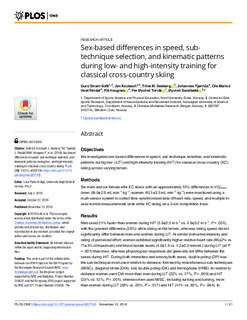| dc.contributor.author | Solli, Guro Strøm | |
| dc.contributor.author | Kocbach, Jan | |
| dc.contributor.author | Seeberg, Trine Margrethe | |
| dc.contributor.author | Tjønnås, Johannes | |
| dc.contributor.author | Rindal, Ole Marius Hoel | |
| dc.contributor.author | Haugnes, Pål | |
| dc.contributor.author | Torvik, Per Øyvind | |
| dc.contributor.author | Sandbakk, Øyvind | |
| dc.date.accessioned | 2019-04-02T06:46:48Z | |
| dc.date.available | 2019-04-02T06:46:48Z | |
| dc.date.created | 2018-12-22T18:24:14Z | |
| dc.date.issued | 2018 | |
| dc.identifier.issn | 1932-6203 | |
| dc.identifier.uri | http://hdl.handle.net/11250/2592801 | |
| dc.description.abstract | Objectives We investigated sex-based differences in speed, sub-technique selection, and kinematic patterns during low- (LIT) and high-intensity training (HIT) for classical cross-country (XC) skiing across varying terrain. Methods Six male and six female elite XC skiers with an approximately 15% differences in VO2max (men: 68.9±2.9 mL·min-1·kg-1, women: 60.1±3.3 mL·min-1·kg-1) were monitored using a multi-sensor system to collect time-synchronised data of heart rate, speed, and multiple tri-axial inertial measurements units while XC skiing on a 5-km competition track. Results Men skied 21% faster than women during HIT (5.9±0.3 m·s-1 vs. 4.9±0.2 m·s-1, P < .001), with the greatest difference (26%) while skiing on flat terrain, whereas skiing speed did not significantly differ between men and women during LIT. At similar instructed intensity and rating of perceived effort, women exhibited significantly higher relative heart rate (85±2% vs. 71±3% of maximum) and blood lactate levels (4.0±1.3 vs. 1.2±0.2 mmol/L) during LIT (all P < .001) than men, whereas physiological responses did generally not differ between the sexes during HIT. During both intensities and among both sexes, double poling (DP) was the sub-technique most used relative to distance, followed by miscellaneous sub-techniques (MISC), diagonal stride (DIA), kick double poling (DK) and herringbone (HRB). In relation to distance women used DIA more than men during LIT (22% vs. 17%, P = .009) and HIT (23% vs. 12%, P = .001), whereas men used MISC, including tucking and turning, more than women during LIT (39% vs. 25%, P = .017) and HIT (41% vs. 30%, P = .064). In particular, men used DP more than women while skiing the uphill sections during both LIT (24% vs. 11%, P = .015) and HIT (39% vs. 13%, P = .002). Conclusions Our findings provide novel insights into sex-based differences in speed, sub-technique selection, and kinematic patterns during LIT and HIT for classical skiing. | nb_NO |
| dc.description.abstract | Sex-based differences in speed, sub-technique selection, and kinematic patterns during low- and high-intensity training for classical cross-country skiing | nb_NO |
| dc.language.iso | eng | nb_NO |
| dc.publisher | Public Library of Science (PLOS) | nb_NO |
| dc.rights | Navngivelse 4.0 Internasjonal | * |
| dc.rights.uri | http://creativecommons.org/licenses/by/4.0/deed.no | * |
| dc.title | Sex-based differences in speed, sub-technique selection, and kinematic patterns during low- and high-intensity training for classical cross-country skiing | nb_NO |
| dc.type | Journal article | nb_NO |
| dc.type | Peer reviewed | nb_NO |
| dc.description.version | publishedVersion | nb_NO |
| dc.source.volume | 13 | nb_NO |
| dc.source.journal | PLoS ONE | nb_NO |
| dc.source.issue | 11 | nb_NO |
| dc.identifier.doi | 10.1371/journal.pone.0207195 | |
| dc.identifier.cristin | 1647019 | |
| dc.relation.project | Norges forskningsråd: 245625 | nb_NO |
| dc.relation.project | Norges forskningsråd: 245622 | nb_NO |
| dc.description.localcode | Open Access. Research accepted by PLOS journals is published under a CC BY license. Anyone may reuse the article with proper attribution. | nb_NO |
| cristin.unitcode | 194,65,30,0 | |
| cristin.unitname | Institutt for nevromedisin og bevegelsesvitenskap | |
| cristin.ispublished | true | |
| cristin.fulltext | original | |
| cristin.qualitycode | 1 | |

